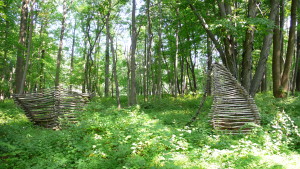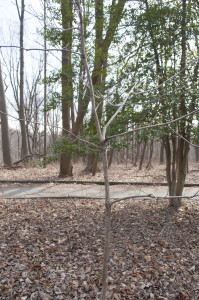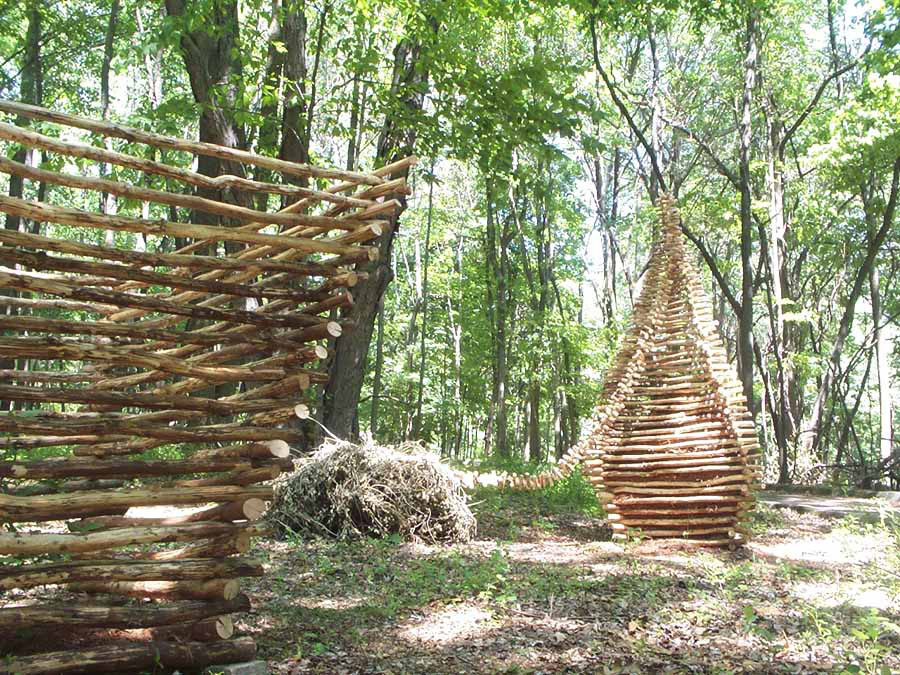By Liz Jelsomine, Environmental Art & Public Relations Intern
 Restoring, protecting, and preserving nature is no small task, and when that land is comprised of worn-out farmland overwhelmed with invasive species, the job becomes even more of a challenge. Artist Bill Botzow realized this when he visited the Schuylkill Center in 2002, stating, “The Center’s commitment to restoring the land while educating the public is impressive and I would like to contribute to support that effort by highlighting some of the Center’s environmental restoration practices and strategies.”
Restoring, protecting, and preserving nature is no small task, and when that land is comprised of worn-out farmland overwhelmed with invasive species, the job becomes even more of a challenge. Artist Bill Botzow realized this when he visited the Schuylkill Center in 2002, stating, “The Center’s commitment to restoring the land while educating the public is impressive and I would like to contribute to support that effort by highlighting some of the Center’s environmental restoration practices and strategies.”
Botzow observed and quickly learned about the main challenge the Center faces; invasive species. He decided to create three wooden structures, titled En, In, Ex-Closure. Comprised of natural and native materials, each served different ecosystems and addressed this large problem.
The first of Botzow’s pieces was a spiraling wooden installation representing the disastrous and profound effects that uncontrolled invasive species growth has on the native landscape as a result of overwhelmed native soil conditions. Plants that are native and supported at the Schuylkill Center include milkweed, swamp white oak trees, and pagoda dogwood plants. However, Japanese Stilt Grass, Oriental Bittersweet, and Garlic Mustard make up the top least wanted invasive species at the Schuylkill Center, and disrupt the natural process by displacing native plants and creating monocultures.
Another of his creations acted as a container for white pine needles, a natural soil acidifier beneficial to native plant species. Until the mid-1960’s the majority of the land that is now part of the Schuylkill Center and surrounding area was farmed. If you look at the Center’s woodlands, you will see that the trees are all relatively young. Farming resulted in the area being cleared of native plant life and the soil depleted of nutrients, leaving the land vulnerable to invasive species. Botzow created this piece in mind of the work the Schuylkill Center does to restore the soil’s nutrients to aid in the re-growth of native species.
Botzow’s third piece was a structure to protect native species from deer grazing. Deer especially enjoy snacking on young plants that the Schuylkill Center works to support, killing the new growth before they ever have a chance to mature. Botzow’s structure formed a protective barrier around an oak tree sapling, in hopes that it would be able to mature and take its rightful role as a native tree.
Botzow’s work remained at the Schuylkill Center until it had to be removed in 2016 due to deterioration; however, his work left a lasting impression. The fragile sapling that he protected with one of his creations has grown into a vibrant, healthy oak tree that will live on at the Schuylkill Center for years to come.
This collection combined all of the aspects necessary for one to fully grasp the importance of protecting our native environment. From understanding the impact that invasive species have on overused and depleted land and the solutions needed to restore the soil and replenish native species, to seeing the long-term results and appreciating the beauty of nature as it was intended.
Editor’s note: The Schuylkill Center produced a wall calendar for 2017 in celebration of the environmental art program. Throughout the year, we’ll run a monthly post on our blog highlighting the art works featured in that month of the calendar. Calendars are still available, only $5 each!

